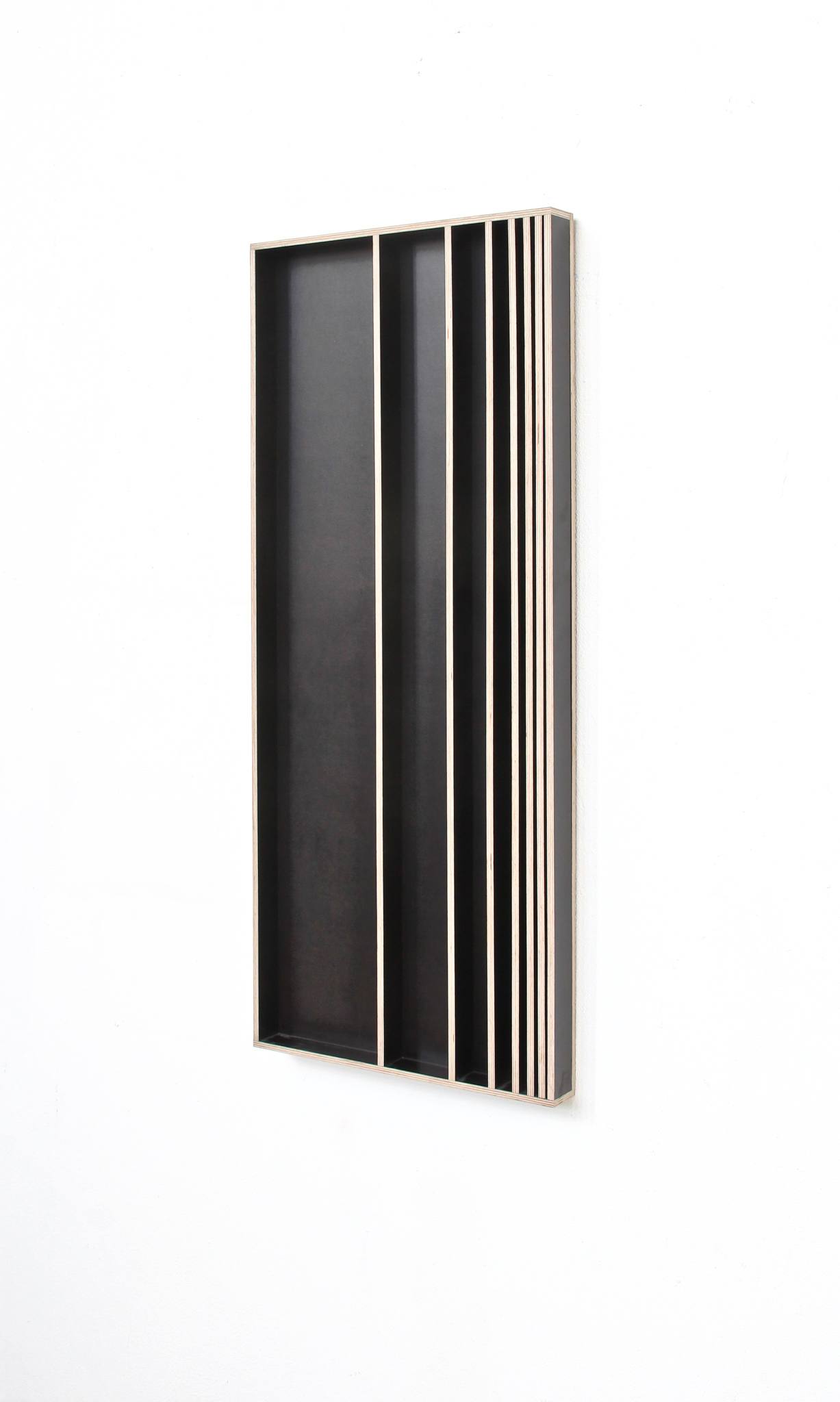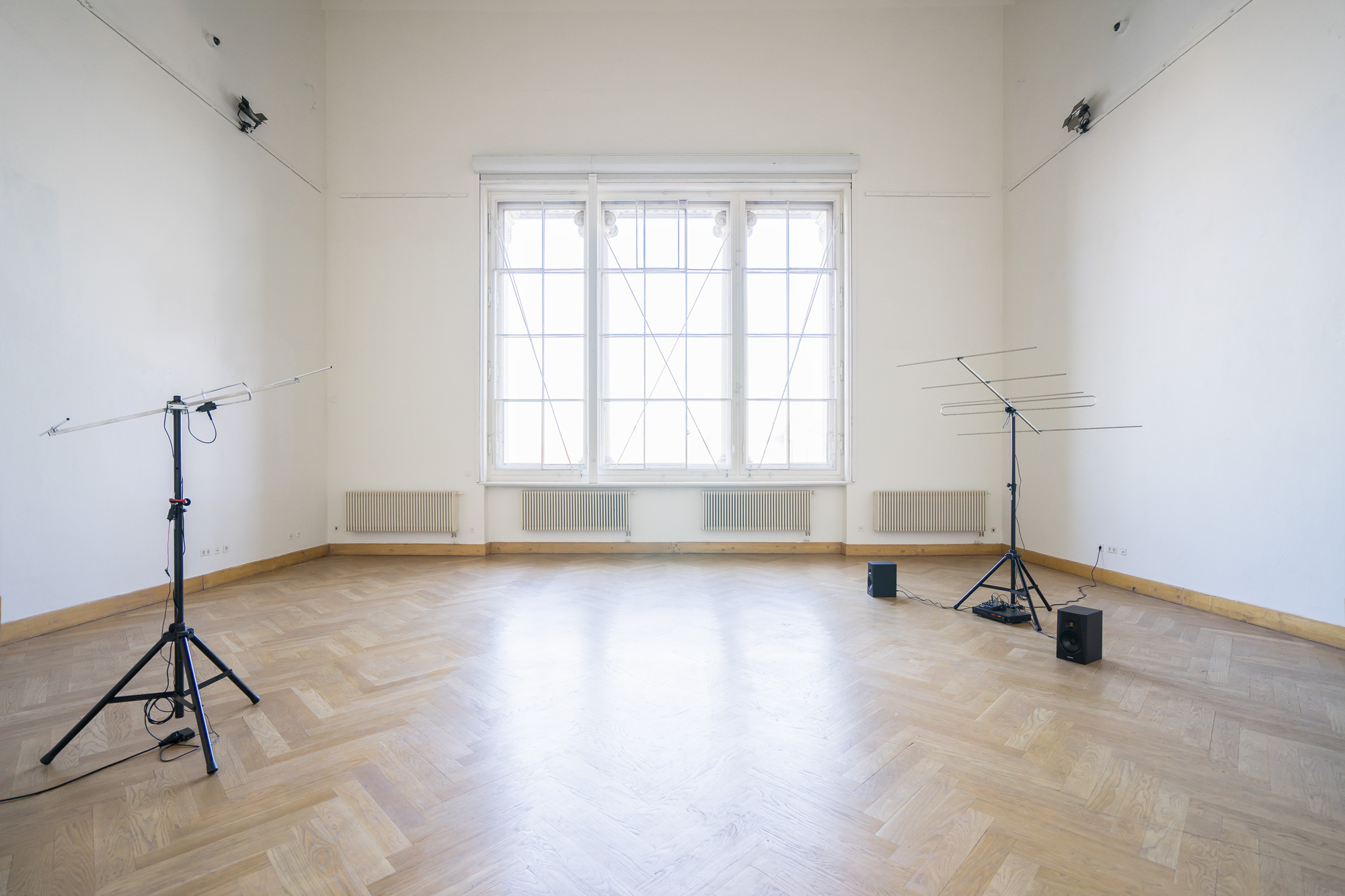
























1 art student, science graduate
2 2022
radio installation
steel, transmitter, media player, microphone, battery, cables, hairs (500 x 150 x 100 cm)
The Radio Rattler is speculative Technology and Biology, spectral sculpture and interference platform. This being tells of a time, when biology and technology follow their own ways of change, radically far away from humans. Perhaps the Radio Rattler once was a radio that moved on from its human-given purpose to become self-paced. Feeling the electro-magnetic radiation in various bandwidths, it somewhen decided to transmit and interfere with its surroundings, possibly out of a whimsey. It doesn’t see or hear in a human way and so the Radio Rattler also strangely abandoned its individual way of being. It can only be by transmitting and receiving, thus forming a node in a vast spectral sculpture of radio waves. As radio once was an idealist socialist dream of connecting people through space and time, the Radio Rattler is retro-fitting the past into a future that already happened. By neglecting all hierarchies and licensings in the radio space it reduces radio to its roots of an egalitarian connecting space - and reviving hopes for a radio-based utopia.
Ps: If you earned its trust and affection it will readily transmit your broadcasts.
3 2021
radio installation
radio transmitter, antennas, radio receiver, speakers (400 x 400 x 200 cm)
At the start of the winter semester 2021/2022 Klasse Philipsz began delving into the world of analogue radio. We explored various radio archives and studied works by artists that were designed for transmission, culminating in a radio workshop. Each student engaged in their own way with the material to produce a unique sound work that has been designed for transmission. The project was titled Radio International and was experienced in the Senatsaal of the HfBK Brühlsche Terrasse .While most transmission art is made to be experienced at home or from a private location we set out to produce transmissions that would be experienced as a sound installation within a specific architectural context.
4 2021
film
1 channel video, 2 channel audio (11:31 min)
Claus Schöning Lam Yong has worked with the Electron Microscopy Center (EMZ) of the University Hospital of Jena. He was particularly investigating the course of the scientific protocol as a tool of human knowledge production. His work Beast Science is both a documentary and a science fiction reenactment. A complete protocol of the sample preparation for scanning electron microscopy is performed in minute detail by a seemingly non-human agency. Furry paws and long claws prompt the question what science may become if it is devoid of humans, imagination or meaning. The shots in part are kept in extreme proximity and played back in slow motion, which relates the practice of filming to the documented practice of microscopy, but also creates a sense of haptic and materiality in the images. The prominent sound of the work, which by no means takes a back seat to the visual component, was composed by the artist specifically for the work and accompanies citations of interviews, which the artist conducted with scientists from EMZ.
videography by Julius Wincker* and David Scheffler*
5 2021
film
1 channel video, 2 channel audio (08:58 min)
sound installation
speakers, amplifier, reverb, microphone, mixer, cables, fog machine, selection of books by Aristotle (450 x 350 x 400 cm)sound installation
speakers, door (05:36 min)
Everybody is confused is a poem. It was adopted as a video work and as sound installations. In the video work five interludes of romantic-style piano music alternate with five passages of the lyrics. The poetic verses seem to coalesce with the noise and fog exhaled by the fog machine, confronting us with the uncertainties of a scientific belief system in times of information bubbles. What and who to belief is presented as an opaque network of feelings, which are expressed by the emotionally loaded musical interludes. The installative works materialise the network from which the poem tells as an ecosystem of different non-human agents, which together produce fog and sound. The sound of the fog machine is captured by the microphone, reflected through a reverb and then feeds back into the microphone via the speakers. Books of Aristotle encumber on the on switch of the fog machine, thus passively activating the feedback loop. The space is densely filled with fog, while the sound scape evokes a sense of forlornness. The setting is reminiscent of the so called Ganzfeld experiment, which induces hallucinations due to sensory deprivation.
6 2019 - 2020
.pdf file (104 KB)
The work How to Isolate and Amplify Clostridium Botulinum investigates how military powers are embodied by scientific practices. The bacterium Clostridium Botulinum is omnipresent in most soils and produces the highly lethal Botulinum Toxin. In the protocol proposed by the work a detailed hands-on instruction is given of how to isolate and grow weaponizable quantities of the toxin producing bacteria. The protocol contains all materials needed, including hyperlinks to internet vendors of necessary materials with an overall cost of approximately 6000 USD and a time exposure of about 200 hours to produce significant amounts of the toxin. In the early 1990s the Japanese terrorist group Aum Shinrikyo used botulinum toxin at least on 3 occasions. Luckily the attacks failed due to unknown reasons. After the 1991 Persian Gulf War, Iraq admitted to the United Nations of having 10 000 L of weaponised botulinum toxin, more than any other biological weapon used by Iraq at that time. Their total stock supply of 19 000 L would approximately constitute the amount needed to kill humanity 3 times by inhalation. While military use of botulinum toxin is dismissed by contemporary research, a terrorist use of the substance is a realistic scenario. The protocol is the result of an online research, considering freely available scientific publications and copying from their methods. The protocol can be circulated as folded brochures or posters with QR codes linking relevant resources.
7 2020
film
1 channel video, 2 channel audio (09:20 min)
A zoom presentation was adopted as a poem for the international conference Taboo - Transgression - Transcendence in Art & Science 2020. This poem presents the research for the work How to Isolate and Amplify Clostridium Botulinum in a poetic and narrative form. It is told by the much-loved Emojis, while the research is passing by on the graphic user interface of a computer, illustrating the modus operandi of 2020 and years to come.
8 2018
film
1 channel video, 2 channel audio (4:04 min)installation
refridgerator, multiplex, plastics, photo print on alu dibond, roses, silkscreen
print, candle (650 x 300 x 200 cm)
What is Love? A social construction? A measurable state of matter? The video work How To Make Love presents the imaginary production process of love as a substance, blending a documentary style with music video formats. While the production process is both shown and described, the performer seems to sing a love song along the dramaturgy of the production process. How can emotions be materially reproduced in times of online dating and pharmacopornography? How To Make Love is a demonstration of how ideas are constituted by their material practice of production.
9 2019
videoinstallation
1 channel video, 2 channel audio (03:23 min)
binoculars, telescope, tripod, pedestal, headphones, screen
Do two protest movements - the revolution of 1989 in the GDR and the 2019 protests in Hong Kong - correspond? Can they be understood as an expression of a timeless phenomenon, the utopian moment? Where do humans in resentment, anger and despair take their hope and the impetus to self-empowerment? With the help of sundry binoculars and telescopes the exhibition space can be explored. Bird`s eye view video footage of the 2019 Hong Kong protest can be found in the distance. The telescope as apparatus of spacial empowerment also implicates the opposite, the being-seen as deprovation from power. At the same time audio recordings of the Dresden police radio from the 8th of October 1989 reference the uncertainties of revolutionary moments. The audio/visual installation addresses the spacial and temporal contingencies of the global utopian moment of democrarcy in it’s formal appearance as mass protest. Is the democratic utopia an essence of the conditio humana? Is only the permanantly revolving democracy instabile enough to allow for the unpredictable hopes of future generations? What happens when the utopian moment stagnates?
Text by Denise Ackermann
10 2019
performance in public space for 3 days
In the performance Pulling the Strings Together (Vienna) a grassland in Vienna, Austria near the Danube canal is reworked for three days by bundling up grass. By placing a technological worker in a seemingly natural environment, the work negotiates the nature culture dichotomy. The Danube canal was constructed in the 16th century opposing the notion of a natural environment and reminding us of gardening practices like the English landscape garden, which tried to reproduce a romanticised image of nature.
11 2017, 2018, 2019
MDF, multiplex, microorganisms (200 x 60 x 25 cm)
The works from the series When Math Becomes Real It Dies are instructed by mathematical functions and thus could be termed mathematical representations. Math is used in the sciences to predict phenomena and the associated question if math is a representation of these phenomena still seems to be vexing the legitimation of scientific knowledge and some mathematical philosophers. The objects of this series can be seen as the material witnesses of this representational discourse. Despite an utterly accurate production process they are abandoned to a microbial disintegration. The exponential function represented in the object is finally performed by airborne contamination during their exponential growth phase. While invoking the well established questions of originality, precision and accessibility which are at the core of representational discourses they also subvert the very same - literally - by their decomposition.
12 2016, 2017, 2018, 2019, 2020
silcreen prints on paper, various formats
The materials used in the series Metamaterial are (per)forming their very own structural formulas, molecular formulas, systematic names and visualites. Dyes and pigments were among the first mass products of the chemical industry, following TNT in the late 19th century. The widespread aesthetical craving for colourful images lead to intense research on the materiality of visibility. The adopted architectural paradigm form follows function fueled new modes of molecular representations, theories and strategies in synthetic chemistries which originated modern pharmaceutical and biological regimes of production. The series Metamaterial investigates the complex relations between materials, their productions and their representations. Opposing western representational art, the materials used are representing themselves, therefore starting an endless recursive self-reference.
13 2018, 2019, 2020
12”/10” vinyl records
As part of the label and collective SPANDAU20*, Claus Schöning Lam Yong releases music under his born name Claus Schöning. From 2019-2020 he was determinative of the art direction of the label and collective. Label releases include without limitation music from DAJUSCH, NIKK, NORMAN NODGE, FADI MOHEM, RIFTS, ELLI ACULA, STEFFI, J.MANUEL, FJAAK and ANNA Z.